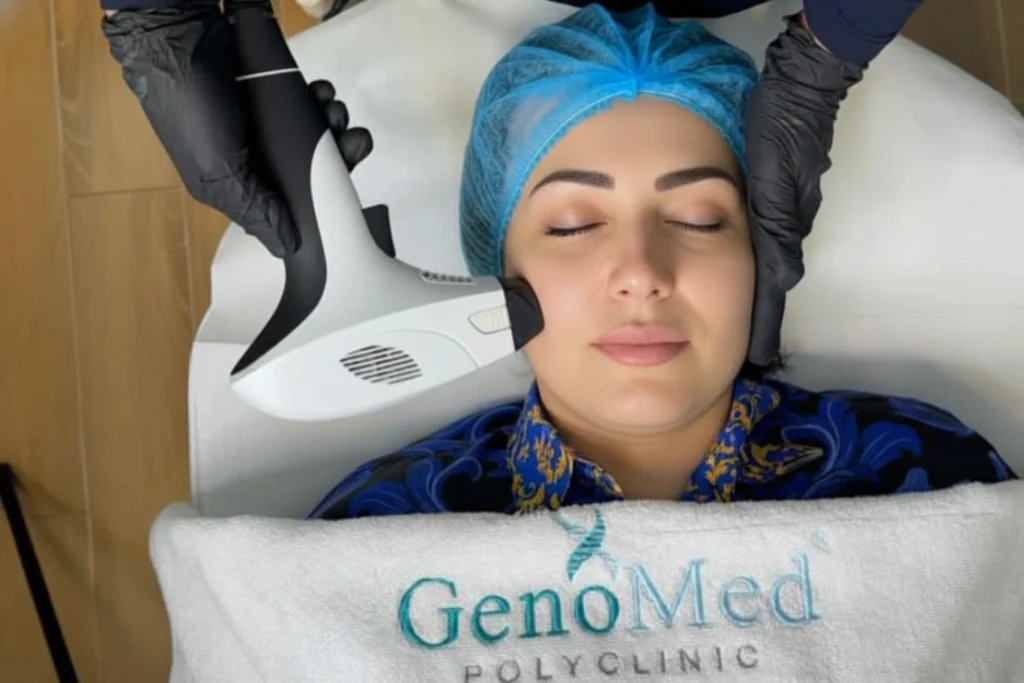RF microneedling (VFR) marries two technologies, mechanical needling and controlled radiofrequency heat, to stimulate collagen deeper in the dermis while keeping the surface intact. For Dubai patients with pitted acne scars, visible pores, or mild lower-face laxity, this can produce meaningful texture refinement with modest downtime when performed under medical parameters designed for Fitzpatrick IV-VI. Clinical literature supports RF microneedling as effective for atrophic acne scars and skin laxity with good tolerability profiles.
What RF Microneedling (VFR) Actually Does, and Why It’s Different
Conventional microneedling (e.g., Biosome Skin Pen) creates micro-channels that trigger a wound-healing cascade and new collagen, which already helps rolling/boxcar scars and pores. RF microneedling (VFR) adds a precisely dosed thermal stimulus at the needle tips, denaturing collagen in a controlled way so it re-forms tighter and more organized, useful for texture plus early laxity. Studies and reviews report improvement in acne scarring and tightening with RF microneedling, often with high patient satisfaction.
Bottom line:
Biosome Skin Pen (non-thermal): excellent for texture with low PIH risk.
RF Microneedling (VFR): texture + tightening potential due to heat in the dermis.
Both are safe options when parameters are chosen for skin tone and indication. Reviews in skin of color suggest low PIH risk with RF modalities when used appropriately.
Who’s a Good Candidate in Dubai? (By Concern & Skin Tone)
Best fits for RF Microneedling (VFR):
Atrophic acne scars (rolling, shallow boxcar) that look worse in side-lighting.
Enlarged pores/orange-peel texture on cheeks and nose.
Mild to early laxity in lower cheeks/jawline where subtle tightening is desired.
May need combined approach or alternative:
Ice-pick scars: often need focal TCA-CROSS in addition to needling modalities.
Active acne or barrier flare: calm and repair before procedures (reduces PIH risk).
Keloid tendency: individualized caution.
Fitz IV–VI note: RF microneedling and standard microneedling are both favored in skin of color vs aggressive resurfacing because energy is delivered below the epidermis and parameters can be conservative; peer-reviewed reviews report low rates of dyspigmentation when properly performed.
RF Microneedling (VFR) vs Biosome Skin Pen Microneedling: When We Choose Each
For predominantly texture (scars/pores) with minimal laxity: start with Biosome Skin Pen, then escalate if needed. Evidence consistently supports microneedling for atrophic scars with multiple sessions.
For texture + early laxity or thicker dermis: consider RF Microneedling (VFR) to leverage thermal tightening while remodeling scar tissue.
For severe, narrow ice-pick scars: add TCA-CROSS selectively.
How Many RF Microneedling (VFR) Sessions? Spacing & What to Expect
Most acne-scar patients in clinical studies and reviews improve over 3–5 sessions spaced 4–6 weeks apart (similar cadence to standard microneedling). A maintenance touch-up every 6–12 months helps preserve results. Expect transient redness for 24–72 hours and textural gains that accumulate over months as collagen remodels.
Pairing RF Microneedling (VFR) with Our Other Services
Medical Facials & Chemical Peels (for PIH and Glow)
When brown marks (PIH) sit over scars, we typically alternate pigment-safe lactic/mandelic peels or enzyme-led medical facials between RF sessions to manage color while RF handles texture, an approach favored in skin of color to limit cumulative inflammation.
Chemical Peel in Dubai • Medical Facials
Biosome Skin Pen (for gentle collagen induction)
For first-time patients or very pigment-reactive skin, we may begin with Biosome Skin Pen and progress to VFR once tolerance and response are established.
Skin Booster Injections (for hydration & finish)
Once texture improves, skin boosters add hydration and surface radiance, often scheduled a few weeks after a needling session to complement remodeling.
PRP Add-On (case-by-case)
PRP can be paired with microneedling series to enhance perceived improvement and satisfaction without increasing serious adverse events in studies. (Evidence is strongest with standard microneedling; data with RF + PRP is emerging.)
Note on Cynosure Elite+ (LHR): Elite+ is primarily our laser hair removal device; while the platform can target certain benign pigmented/vascular lesions under dermatologist settings, it is not a first-line acne-scar or PIH modality at Genomed. We focus on peels/needling for pigment and RF/needling for scars.
Dubai-Specific Aftercare (PIH Prevention First)
SPF 50+ daily, reapply outdoors every 2–3 hours; hats/shade are non-negotiable.
Avoid heat, saunas, intense workouts for 48 hours (limits inflammation).
No acids/retinoids/scrubs for ~1 week; use gentle cleanser + barrier moisturizer.
Adjunct LED (red/NIR) may be used post-procedure to support wound-healing dynamics and calm inflammation, helpful but not mandatory.
The Genomed Method: VFR Safety for Fitz IV–VI
Our clinician-led protocols are built to minimize PIH while delivering steady gains: conservative depth/energy on session one, pigment-prep when appropriate, strict spacing, and progressive parameter ramping only as your skin tolerates. Peer-reviewed reviews in skin of color support the low dyspigmentation risk of radiofrequency modalities when used carefully, precisely how we operate.
Ready to plan your course?
👉 Book your professional skin analysis at Genomed, Dubai
